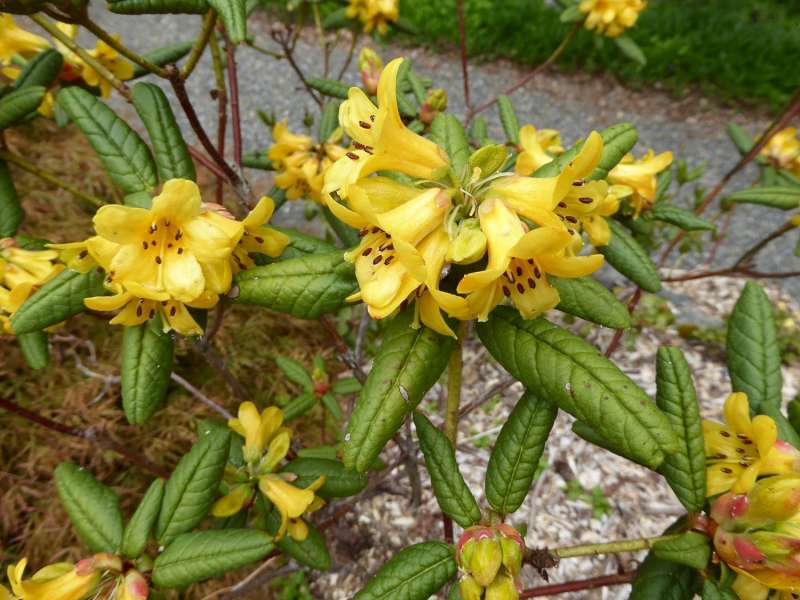Rhododendron valentinioides
Billeder af Rhododendron valentinioides
Beskrivelse
R. valentinioides (Maddenia).
About R. valentinoides, Steve Hootman
Dværgarten har de dybeste gule blomster af enhver rhododendron. Derudover har den glat og afskallet bark og meget dekorativt behåret løv. Kommer fra en sydlig breddegrad, en sart, men smuk arter bemærkelsesværdig tolerant over for kolde temperaturer.
RBGE Herbarium; R. valentinioides
Trees and Shrubs Online; R. valentinianum Forr. ex Hutch.
Small shrub, 0.3–1.3 m; young growth densely setose. Leaves 2.6–3.8(–5) × 1.6–2.2(–3.1) cm, elliptic, apex obtuse, margin entire, ciliate, upper surface with midrib impressed, lower surface brown, with dense overlapping unequal scales. Flowers (l-)2–6, in a loose terminal inflorescence, not scented; calyx 5–7 mm, ciliate; corolla bright yellow, funnel-campanulate, 20–32 mm, outer surface with tube pubescent and scales restricted to the lobes; stamens 10; ovary densely scaly, impressed below the style that is variably scaly towards the base. Flowering March-April. Royal Horticultural Society (1997).
Distribution Myanmar N China SW Yunnan, Guizhou
Habitat 2,700–3,600 m
RHS Hardiness Rating H4
Awards AM 1933 (Hon. H.D. McLaren, Bodnant); flowers yellow.
Conservation status Near threatened (NT)
Taxonomic note This yellow-flowered species is allied to R. fletcherianum but differs in the entire leaves, with a dense brown covering of scales on the undersurface. It is one of the hardier members of Subsect. Maddenia that can be grown successfully outside in the more sheltered gardens of the S & W of Britain. The recently described var. oblongilobatum R.C.Fang is reported to be in cultivation. It differs from the type variety (as described above) in its. shorter (4–5 mm), oblong calyx lobes that are glandular-scaly, not ciliate. Royal Horticultural Society (1997)
An evergreen shrub 3 or 4 ft high; young shoots densely bristly and scaly beneath the bristles. Leaves oval inclined to oblong, 11⁄2 to 2 in. long, 3⁄4 to 1 in. wide, pale green and bristly above, nearly covered with tawny scales beneath, margins bristly; leaf-stalks 1⁄3 to 1⁄2 in. long, bristly and scaly. Flowers two to six in a close terminal cluster. Calyx 1⁄3 in. long, five-lobed, the lobes oblong, scaly outside and densely woolly-hairy on the margin. Corolla bright yellow, between funnel- and bell-shaped, about 11⁄2 in. long, five-lobed, densely scaly outside. Stamens ten, with white hairs at the lower part; anthers pink. Ovary and base of style scaly. Bot. Mag., n.s., t. 623. (s. Maddenii ss. Ciliicalyx)
R. valentinianum was discovered by Forrest in 1917 on the Shweli-Salween divide, Yunnan, near the border with Burma, growing in open scrub at 11,000 ft. In a note accompanying the original description, Sir Isaac Bayley Balfour remarked on the affinity between this species and the Himalayan R. ciliatum, but there are many differences apart from the obvious one of flower-colour, notably that the leaves are smaller in R. valentinianum and densely scaly beneath.
R. valentinianum is a charming species, but, although winter-hardy, it is bud-tender and is really seen to best advantage in a cool greenhouse except in the milder parts. Grown out-of-doors it needs a well-lighted position, otherwise it sets little flower-bud and becomes lanky in habit. It received an Award of Merit in 1936 when shown from Bodnant.





